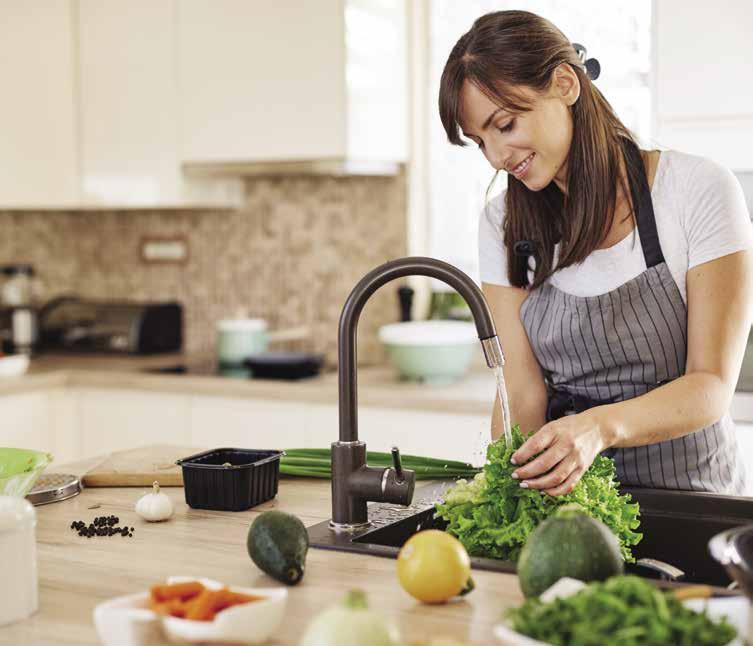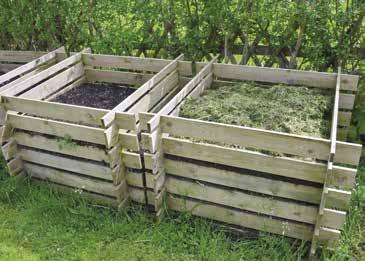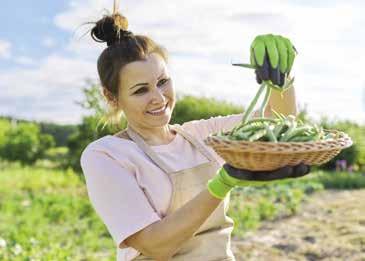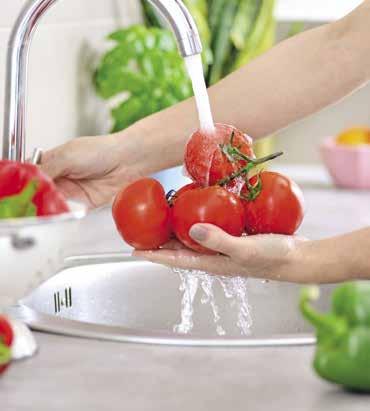
6 minute read
Food Safety
And Your Garden Produce
Increasingly, foodborne illness outbreaks are being traced to lettuce, tomatoes, cantaloupe and other raw fruits and vegetables. Most foodborne illness is caused by the bacteria, viruses, molds and parasites (or pathogens) found on raw produce that is not carefully washed or prepared. Many of these can make you sick. These microorganisms are a natural part of the environment and can be a problem whether you choose to use organic or conventional gardening methods.
Advertisement
It is also possible to get sick from contamination of produce with chemicals such as cleaning solutions, fertilizers, pesticides and heavy metals (lead) and other chemicals that may be found in garden soil or well water.
Five Steps to Food Safe Gardening
Follow the five simple steps listed here and reduce the risk of someone suffering a foodborne illness after eating produce from your home garden.
STEP 1:
PREPARE THE GARDEN FOR PLANTING
• Locate vegetable gardens away from manure piles, well caps, garbage cans, septic systems and areas where wildlife, farm animals or the family pets roam.

Use compost safely. Compost must reach a temperature of at least 130ºF.
• Use compost safely. Compost is the natural breakdown product of leaves, stems, manures and other organic materials – and also a source of pathogens. To be safe for gardening, your compost must reach a temperature of at least 130°F. Check the temperature with a compost thermometer. Do not use any animal waste, including pet waste, meat scraps or dairy product waste in your compost bin.
STEP 2:
MAINTAIN THE GARDEN
Water source: Be familiar with the quality and safety of the water source(s) you use in your garden.
• If you get your water from a municipal or public water system, you can be sure that it is safe and potable (drinkable). • Surface water (lakes, ponds, rivers and streams) can be polluted by human sewage or animal waste, fertilizers and pesticides from lawns and farm fields, or chemicals from industry. • Ground water (which is the source for well water) is less likely to have microbial contaminants than surface water. If a well is your water source, you need to take a little more care to be sure that it is providing you with safe, clean water. • Conduct a standard water test at least once a year to determine if your well water meets the standards of the Environmental Protection Agency (EPA).
Animals: Animal waste can be a source of bacteria, parasites and viruses. • During the gardening season, keep cats, dogs and other pets out of the garden. • Curtail nesting and hiding places for rats and mice by minimizing vegetation at the edges of your fruit and vegetable garden. • Do not feed wild animals, even birds, near your garden. Fencing or noise deterrents may help discourage other wild animals.

Keep cats, dogs and other pets out of the garden.
STEP 3:
HARVEST GARDEN PRODUCE
• Use clean, food-grade containers. Food-grade containers are made from materials designed specifically to safely hold food. Garbage bags, trash cans, and any containers that originally held chemicals such as household cleaners or pesticides are not food-grade.

• Use clean gloves (that have not been used to stir compost or pull weeds) or clean hands when picking produce. • Brush, shake or rub off any excess garden soil or debris before bringing produce into the kitchen.
STEP 4:
STORE GARDEN PRODUCE
• If you choose to wash fruits and vegetables before storing, be sure to dry them thoroughly with a clean paper towel. (NEVER wash berries until you are ready to eat them.) • If you choose to store without washing, shake, rub or brush off any garden dirt with a paper towel or soft brush while still outside. Store unwashed produce in plastic bags or containers. • Keep fruit and vegetable bins clean. • When washing produce fresh from the warm outdoors, the rinse water should not be more than 10 degrees colder than the produce. If you are washing refrigerated produce, use cold water. • Fruits and vegetables needing refrigeration can be stored at 40° F or less. • Fruits and vegetables stored at room temperature (onions, potatoes, tomatoes) should be in a cool, dry, pest-free, well-ventilated area separate from household chemicals.
PREPARING AND SERVING FRESH GARDEN PRODUCE

More often than not, we eat fresh fruit and vegetables raw, so we cannot rely on the heat of cooking to destroy pathogens that might be on our lettuce or tomatoes. It is important to prepare raw produce with food safety in mind.
• Always wash your hands first. • Rinse fresh fruits and vegetables under cool, running, clean water even if you do not plan to eat the skin or rind. • Never use soap, detergent, or bleach solution to wash fresh fruits or vegetables. These solutions can affect flavor and may not be safe to ingest. • Avoid cross-contamination when preparing fruits and vegetables. Cross-contamination occurs when a clean work surface such as a cutting board or utensil (paring knife) or uncontaminated food is contaminated by dirty work surfaces, utensils,

Be sure to wash your hands (as well as the knife and cutting surface) before preparing any ready-to-eat foods such as salad, fresh fruit or a sandwich.

hands or food. Be sure to wash your hands (as well as the knife and cutting surface) before preparing any ready-to-eat foods such as salad, fresh fruit or a sandwich. • If you have leftover produce that has been cut, sliced or cooked, store it in clean, airtight containers in the refrigerator at 40°F or less.
PRESERVING FRESH GARDEN PRODUCE
Canning, freezing or drying fruits and vegetables allows you to enjoy the fruits (or vegetables) of your labor all winter long. Choose and follow recipes and methods that are tested by a United States Department of Agriculture (USDA) endorsed source such as cooperative Extension. Contact your local county Extension office and ask to speak to a Regional Agent in Food Safety for more preserving questions or go online to the National Center for Home Food Preservation that is operated by the Georgia Extension Service.


February 2- Alabama Cottage Food Law
March 2- Egg Safety
April 6- Spring Cleaning in Your Kitchen
May 4- Water Bath and Pressure Canning
June 1- Tips for Summer BBQs
July 6- Drying, Pickling, and Fermentation
August 3- Starting a Food Business
September 7- Food Safety for Groups
October 5- Alabama Cottage Food Law
November 2- Holiday Food Safety Scan the QR Code or submit your questions at www.aces.edu/go/TableTalkTuesdays












